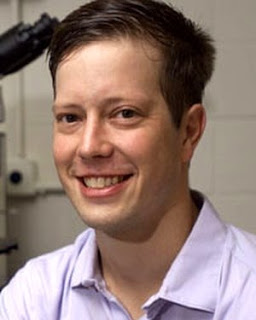“Our group and other research groups worldwide are examining what makes these fullerene aggregates tick and how they form,” said Peter Vikesland, associate professor of civil and environmental engineering at Virginia Tech. “Once they clump, they don’t settle out. People don’t know why they remain suspended. And we don’t really know how many molecules are in a clump. We use the term nC60 where N means some number that is extremely large.”
What Vikesland’s group has done that is different and novel is, instead of mixing the molecules with water, they have added citric acid, a naturally occurring and readily available acid. “The result is that instead of unstructured clumps, we get reproducible sphere-shaped aggregates,” he said.
They discovered, for example, that in the presence of a little bit of acid, which emulates the environment in the case of an accidental release of fullerenes, the aggregates are similar to those formed in water alone. But when more acid is added, the diameter of the aggregates becomes smaller. “We want to understand the implications of this finding to the toxicity, movement, and fate of fullerenes in the environment.”
Citric acid is well understood as a proxy for other kinds of organic acids, including those within cells. Some of the citrate-based spheres that Vikesland’s group discovered are similar to what happens intercellularly when human cells are exposed to C60, he said. “We think citrate and other organic acids with a carboxyl group make C60 more water soluble.”
Vikesland will present “Effects of small molecular weight acids on C60 aggregate formation and transport (ENVR 26)” to the Division of Environmental Chemistry at 1:35 p.m. Sunday, April 6, in room 235 of the Morial convention Center. Authors of the paper are Vikesland, civil and environmental engineering Ph.D. student Xiaojun Chang of Luoyang, Henan, China, and master’s degree student Laura K. Duncan of Augusta, Ga., and research assistant professor and TEM lab director Joerg R. Jinschek
Future environmental research will be done with simulated subsurface environments using a sand column to determine how these acidified masses move in ground water.
Vikesland will present Chang’s and his research about how C60 and citric acid interact to the Division of Colloid and Surface Chemistry on Wednesday, April 9, at 4:30 p.m. in 225 Morial Convention Center. He will present the results of various imaging analysis, such as atomic force microscopy. “We have no answers but we have a hypothesis, still unproven, that there are weak interactions between citrate and individual carbon molecules that cause the spherical shape,” Vikesland said.
The Vikesland group is exploring whether the C60-citrate interaction can be used to create reproducible shaped objects. Many fullerene-based products presently require solvents, which are then washed off. Unfortunately, the engineered fullerenes can retain solvents. Using citrate “is very green chemistry,” Vikesland said. “There are no solvents. It is a cleaner way to produce these things. Citrate may be an alternative.”
But there are challenges. “It’s not a hard bond but a weak attractive force, which makes these spherical aggregates challenging to work with. At the present time we don’t know how they will fall apart and what their products are,” Vikesland said.
In the meantime, the solvent issue aside, the current rush to put fullerenes into materials may not be wise “because we don’t understand what is going on,” said Vikesland. “If you have a face cream with fullerenes as an antioxidant – we don’t know how they will react. There are many organic acids in the environment.”
He concludes, “There are uncertainties. Everyone wants to prevent future problems.” ###
Vikesland's research is supported by the National Science Foundation. The project was also supported by the Institute for Critical Technology and Applied Science at Virginia Tech.
Contact: Susan Trulove STrulove@vt.edu 540-231-5646 Virginia Tech
Tags: Nano or Nanotechnology and Nanotech or Virginia Tech and Fullerenes or buckyballs















No comments:
Post a Comment